I’m just going to say it.
If you aren’t willing to learn how to write a pitch, you aren’t going to last long as a freelance writer.
In fact, you probably won’t land a single high-paying gig.
And before you know it, you’ll find yourself crawling back to your 9-to-5 and becoming so upset about your work situation that you spend all of your time outside of work binge-drinking yourself into oblivion.
Not a good look (trust me — I’ve been there).
Now, I have a confession to make. When I started freelance writing, my pitches were really bad.
And not just kinda bad.
I’m talking shitty with a capital S here, friend.
But I read countless blog posts and tweaked my pitch until it started landing me the clients I wanted.
I pretty much got pitching down to a science.
I started landing most of the gigs I pitched because of my strategic, tested approach to pitching!
And because of that, I got to a point where had so many clients that I wanted to start outsourcing some of my work (specifically, blogging and copywriting work).
So, I put a job ad online to see if I could find good freelance writers to help me out.
And, let me tell you… suddenly being on the receiving end of pitches was SO. DAMN. EYE-OPENING.
It really helped me understand the struggle and frustration that editors must face every time they post a job ad.
So today, I’m going to teach you how to write a pitch by teaching you how not to write a pitch.
We’ll go over 10 of the worst pitches I received, I’ll explain why they didn’t work, and then I’ll give you some tips so you can write pitches that’ll land you high-paying clients and opportunities to write for MAJOR sites – even as a total beginner.
Ready?
Cool. Let’s get started.
(PSST! Wanna learn the 3 steps to making $1,000 freelance writing in the next 45 days or less (even if you have NO experience)? Join over 7,000 writers, and sign up for instant access to the free class now!)
10 Awful Pitches That Editors Reject Every Time (AKA How *NOT* To Write A Pitch!)
1. The Great Wall of Text
I didn’t even make it through the first paragraph of this snooze fest before I moved on to the next pitch in my inbox.
It was basically a long ass wall of text.
…Mostly full of shit I didn’t care about, like:
- “I have a degree from <insert fancy university here>.”
- “I truly love writing, and I pride myself on my creativity.”
- “I create compelling, creative content, and I make sure it is error-free.”
(Quick tip: writing creative, error-free content is NOT A SELLING POINT. It’s the bare minimum expectation. You’ve gotta do a better job of selling yourself than that!)

If you’re a freelance writer, sending this type of email just makes you look bad.
Seriously.
Remember, your email itself is a sample of your writing, and if it’s not easy to read, you’re not going to get hired.
So, next time you pitch, ditch the Great Wall of Text and break up your content with bulleted lists and white space.
Keep it as short as you possibly can.
…Like what I did in these screenshots of 3 successful pitches that landed me gigs on major websites!
And make sure EVERYTHING in your email is there for one purpose:
Selling your services / proving your value.
You don’t need to tell your life story – just include information that’s relevant to the specific business/person you’re pitching.
For example, if you’re pitching a technology blog, you could talk specifically about your technology experience or the results you’ve driven for a technology company.
Again:
Keep. It. Relevant.
2. The copied-and-pasted pitch
It’s painfully obvious when I receive a pitch that has been copied and pasted.
The only thing this kind of pitch is good for is showing how many fucks you don’t give.
This means you sure-as-shit aren’t getting hired anytime soon, my friend.
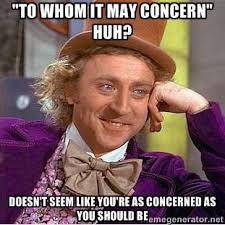
I mean, put yourself in an editor or businessperson’s shoes for a second.
Are you going to respond to a cookie-cutter pitch that could have been sent to anyone?
Nope.
What you WILL do is give that copied-and-pasted pitch a one-way ticket to the “Trash” folder.
Don’t let that happen to your pitches.
You need to customize every pitch (like I did in these screenshot examples of successful pitches) by including:
- The editor’s name – You can almost always find this online if you look hard enough. Try Twitter, LinkedIn, or a Google Search if it’s not on the company website.
- A specific compliment – This isn’t really necessary, but I’ve found it helps as long as you don’t go overboard and sound like a total suck-up. For example, you could say how you really enjoyed a specific blog post the editor wrote, and add a sentence or two about a point in that blog post you found really interesting/compelling.
- A bit about how you can help them SPECIFICALLY – It’s so important to communicate why and how you can help the company achieve the results they want. Remember, when they hire a writer, they’re not paying for words – they’re paying for the business results they’ll get from those words (traffic, leads, etc.).
And be friendly in your pitch too!
Remember, even businesspeople are human beings.
…Meaning they want to be talked to like *GASP* actual human beings.
Trust me. It’s refreshing (and rare) to get an email that doesn’t sound like a stuffy business memo!
3. The direction ignorer
When I posted my freelance writing job ad, I included specific instructions that CLEARLY said to email me a couple of writing samples.
And guess what this guy said in his email?
This:
I just sat there thinking:
“Well, yes. You would need to provide writing samples. And you’d know that if you actually took the time to read this short, simple job ad.”
…SMH.
My friend, don’t be this guy.
Because if you blatantly ignore an editor’s wishes, they’re going to see that as a red flag.
I mean, if you can’t follow the basic instructions outlined in the job ad, how can they expect you to take direction so you can produce the kind of content they need?
They can’t. And they won’t hire you.
So, read every single word of every job ad you respond to.
(Or, if you’re guest posting, make sure you read EVERY SINGLE guest post requirement. And pitch accordingly.)
You might find that they’ve put special requirements in the ad to weed out people who can’t follow basic instructions, like this:
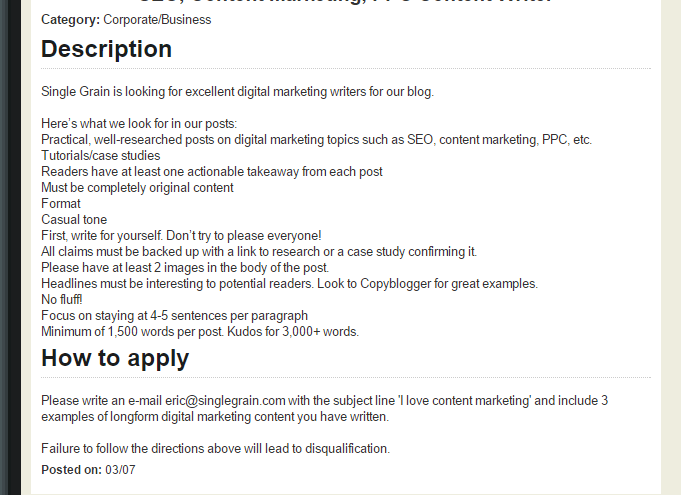
See how the content at the bottom mentions specific instructions for the subject line and writing samples?
Any writer who doesn’t follow these basic instructions?
One-way ticket to the “Trash” folder.
Harsh, but true.
4. The beggar
No matter how desperate you are for work, don’t resort to begging.
It doesn’t work.
It just makes you seem unprofessional and more self-serving than client-focused.
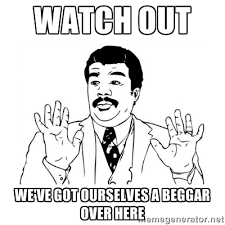
Think about it.
If YOU were an editor and received a pitch that said this:
“Please give me a chance to show you that I’m a good writer.”
…Wouldn’t you be immediately turned off?
Of course you would.
If a writer is asking you to “just give them a chance,” you’re going to automatically assume that they’re saying this because they’re insecure and incapable of producing whatever you’re asking for.
So, if you’ve been approaching pitching this way, stop.
And start positioning yourself as a confident writer who is fully capable of delivering what the client needs.
5. The wrong fit
This guy straight-up said that he didn’t have any relevant samples to send me.
I was hiring freelance bloggers/copywriters specifically, and he had only worked as a journalist.
So, he sent me lots of journalistic articles, but nothing relevant to my job posting.
That’s right. No blog posts. No copy. Just journalistic articles.
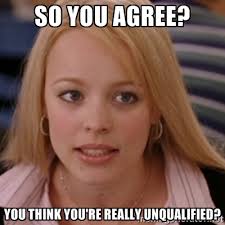
Obviously, that wasn’t going to work for me.
I wanted someone who I could trust to do the job right the first time, or at the very least, someone who could show me that they were capable of writing the content I needed.
And he didn’t.
The takeaway here is to tailor your writing samples to every client you pitch!
I can’t stress this enough!
If a business/blog wants blog posts about marketing, send examples of blog posts you’ve written about marketing.
If they want B2B website copy, send B2B website copy samples.
You get the picture.
That being said, you don’t have to confine yourself to your niche 100% of the time.
If you really want a writing gig that involves a topic you haven’t written about much in the past, go for it – just send your best work over and show that you’re passionate about the topic.
But know that the BEST use of your time is choosing a niche and spending all of your time pitching to clients/blogs in that niche.
…And if you need help picking a niche and making your first $1,000 freelance writing?
That’s one of the things you’ll learn ALL about in my FREE class on how to make your first $1,000 freelance writing (even if you have NO experience!):
Don’t miss out – click here and sign up for instant access to the class!
6. The moneymaker
This guy straight up said that he was mostly interested in writing for me because he wanted to earn some money.

I mean, there’s nothing wrong with wanting to make money writing. Duh.
But that doesn’t mean you should say that to potential clients when you’re writing a pitch.
Why?
Because it makes the email more about you than it is about them.
In this particular pitch email that I received, the writer didn’t say one single thing about how he was a good fit for my writing needs, even though I provided plenty of info about what I was looking for.
So, next time you write a pitch, talk about how you’re going to benefit the client – not how the new writing job is going to benefit you.
Don’t even use “freelance writer interested in job” as your subject line.
You HAVE to make everything about the business/person you’re pitching. Not about how you want the gig.
7. The gender bender
This guy called me “sir” multiple times in his pitch.

Now, I know what you’re thinking – that’s kind of a silly thing to be upset about.
But the gender mix-up itself isn’t what irritated me.
It was the fact that he didn’t do enough research on me or my business to know that I am, in fact, female.
The lesson here is that you should research a company and find out who their editor is every time you pitch.
Then, use the editor’s first name in the subject line and the email, and tailor your message to their needs.
Simple, I know.
But you’d be surprised how many people pitch without doing basic research!
Related resource: Learn exactly how I made $800+ in my first month as a full-time freelance writing using the cold emailing / pitching strategy no one is talking about. Click now and get the free guide so you can start landing clients (works for beginners too!).
8. The uncertain one
No editor wants to see this in a freelance writer’s pitch:
“I think I might be able to write the kind of content you need.”

If you’re going to say something like “I think I might be able to do this,” you might as well not waste your time pitching.
If you truly can’t deliver what the client wants, you have two main options.
Either learn how to deliver what they need before you pitch, or don’t pitch at all
If you can deliver but have a confidence problem holding you back, well… welcome to the club!
Tons of writers struggle to confidently pitch, but don’t worry – pitching is a skill that you can learn.
And leaving out phrases like “I think I might be able to…” is a great start.
If you have a well-defined niche, you shouldn’t run into this sort of thing too much.
That’s because you’ll spend most of your time going after writing gigs that align with the niche you specialize in.
9. The non-writer
This writer literally started her email by saying “I have not previously worked as a professional writer.”
A pitch like that will get deleted every time.
Every. Single. Time.
Now, don’t get me wrong – it’s 100% okay to pitch if you don’t have any experience working as a writer.
But that shouldn’t be the first piece information that you volunteer when you’re writing a pitch.
Talk about what you can do instead – even if you’ve never taken on one single freelance writing project before.
Read over the client’s job ad or requirements one more time, and see if there’s something you can mention about how your specific skill set makes you a great pick for the job.
For example, trying to land a dental writing gig?
Mention that you used to work as a receptionist in a dental office (only if that’s actually true, of course)!
This sort of specialized knowledge makes a HUGE difference, even if you have zero formal writing experience.
Because high-paying clients want to hire writers who know what the fuck they’re doing.
And if you flat-out say you’re not a writer, the last thing they’ll think is that you know what you’re doing.
10. The Jargonator
This dude’s email was littered with a barf-worthy amount of meaningless business jargon and pretentious language.
I had to take a second look to make sure it wasn’t written by my last boss (who used words like “leverage” and “synergy” every chance he got… BARF).
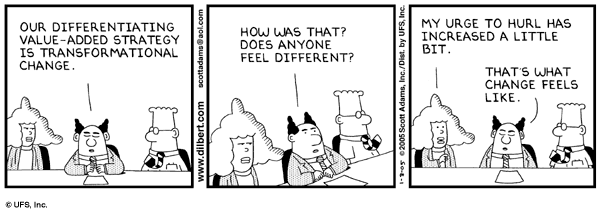
The problem with jargon-filled pitches?
They say a lot without actually saying anything important.
Writing a good pitch is kind of like writing a good resume.
You don’t just say that you’re “creative” and “results-drive” – you show that you’re creative and results-driven in your pitches by using writing samples and proof strategically.
Instead of using jargon and adjectives to try to impress the editor (who is probably ready to tear her eyes out because of the awful pitches she’s seen by the time she reaches yours), talk about the results your content has achieved when you’re writing a pitch.
For example, you could say:
- My latest blog post got shared 10K times on social media, and [name of influencer] even retweeted it.
- The conversion copy I wrote for my last client resulted in a 57% increase in sales.
- I recently wrote an eBook for a client that became their most shared piece of collateral and helped them get 50 new leads in about 3 1/2 weeks.
When you talk about the results you’ve generated for clients this way, you no longer feel the need to include overused adjectives like “creative” and “resourceful” in your pitch.
The results you share will indicate those things and make the potential client a lot more confident in your abilities.
How to Get Your Writing Pitches Accepted Like Crazy – Based on What I Did to Build a $5,000/mo Writing Business in 4 Months!!
Alright, my friend.
That pretty much covers it!
I probably sound kind of harsh in my critiques of these pitches, but that’s not my intention at all – I just want you to know about the mistakes I’ve seen freelance writers make when pitching so you can avoid them.
And hey, if you’ve made several of these mistakes already, don’t beat yourself up.
I’ve done it too (TONS of times), and so has just about every other writer. Gotta start somewhere, right?
The important thing is that you learn from your fuck-ups so you can improve your pitches and start winning more freelance writing clients in the future.
Need help building your freelance writing business and landing clients?
I put together a free class for you, based on exactly what I did to grow my business like crazy after getting fired from my full-time job.
Newbie writers literally email/DM me saying they’re getting clients from this strategy... so click here and join so you can learn.
Don’t miss out – click here to learn how to make your first $1,000 freelance writing in the next 45 days.
See you in the class. 🙂



